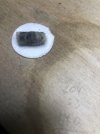Starlite
Well-Known Member
So I've got some CLRCLR is the best that ive found for removing stubborn hard carbon. I just used it today to clean a muzzle brake that you couldnt chip the carbon with a chisel.
That being said.....Be careful with it near any "blued" surfaces it will take off bluing in minutes. Always rinse & neutralize it with water or rubbing alcohol when finished cleaning the part.
Just a word of caution.
What is the process to rid this carbon ring?


